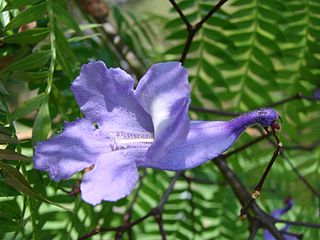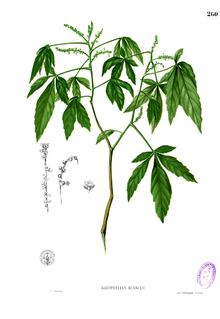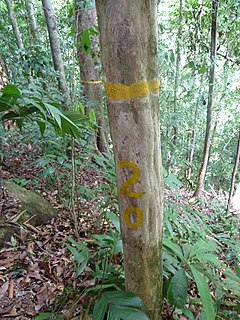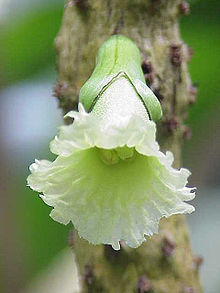
Tabebuia is a genus of flowering plants in the family Bignoniaceae. The common name "roble" is sometimes found in English. Tabebuias have been called "trumpet trees", but this name is usually applied to other trees and has become a source of confusion and misidentification.

Bignoniaceae is a family of flowering plants in the order Lamiales commonly known as the bignonias. It is not known to which of the other families in the order it is most closely related.

Agave americana, common names sentry plant, century plant, maguey or American aloe, is a species of flowering plant in the family Asparagaceae, native to Mexico and the United States in Texas. Today, it is cultivated worldwide as an ornamental plant. It has become naturalized in many regions, including the West Indies, parts of South America, the southern Mediterranean Basin, and parts of Africa, India, China, Thailand, and Australia.

Jacaranda is a genus of 49 species of flowering plants in the family Bignoniaceae, native to tropical and subtropical regions of Latin America and the Caribbean.

Bacteroides is a genus of Gram-negative, obligate anaerobic bacteria. Bacteroides species are non endospore-forming bacilli, and may be either motile or nonmotile, depending on the species. The DNA base composition is 40–48% GC. Unusual in bacterial organisms, Bacteroides membranes contain sphingolipids. They also contain meso-diaminopimelic acid in their peptidoglycan layer.

Cosmos sulphureus is a species of flowering plant in the sunflower family Asteraceae, also known as sulfur cosmos and yellow cosmos. It is native to Mexico, Central America, and northern South America, and naturalized in other parts of North and South America as well as in Europe, Asia, and Australia.

Allophylus is a genus within the plant family Sapindaceae.

Amphitecna isthmica is a species of plant in the family Bignoniaceae. It is found in Colombia, Costa Rica, and Panama. It is threatened by habitat loss.
Amphitecna molinae is an endangered species of plant in the family Bignoniaceae. It is found in El Salvador, Honduras, and Nicaragua.
Amphitecna sessilifolia is a species of plant in the family Bignoniaceae. It is found in Costa Rica and Panama. It is threatened by habitat loss.
Amphitecna spathicalyx is a species of plant in the family Bignoniaceae. It is endemic to Panama.

Alwyn Howard Gentry was an American botanist and plant collector, who made major contributions to the understanding of the vegetation of tropical forests.

Handroanthus is a genus of flowering plants in the family Bignoniaceae. It consists of 30 species of trees, known in Latin America by the common names poui, pau d'arco, or ipê. The latter sometimes appears as epay or simply ipe (unaccented) in English. The large timber species are sometimes called lapacho or guayacan, but these names are more properly applied to the species Handroanthus lapacho and Handroanthus guayacan, respectively.

Roseodendron is a genus of flowering plants in the family Bignoniaceae. It consists of two species, Roseodendron donnell-smithii and Roseodendron chryseum. The type species for the genus is R. donnell-smithii. Both species are cultivated as ornamentals for their numerous, large, yellow flowers.

Jaltomata procumbens, the creeping false holly, is a plant species native to Arizona, USA, Mexico, Central America, Colombia, Ecuador, and Venezuela. It grows as a weed in agricultural fields and other disturbed locations, but in many places the people protect it because of the edible fruits it produces.

Amphitecna macrophylla, commonly known as black calabash or chaff-bush, is a species of plant in the family Bignoniaceae. It is found in small patches of Mexico and Guatemala. It can reach a height of 15 to 30 feet. It is drought tolerant and is hardy to USDA Hardiness Zone 10b.

Bidens bipinnata is a common and widespread species of flowering plant in the daisy family. It is widely dispersed in many lands, so much so that it is difficult to ascertain with certainty its region of origin. It seems most likely, though, that it is native to Asia and North America, and naturalized elsewhere. It is most commonly called by the common name Spanish needles.

Amphilophium is a genus of flowering plants in the family Bignoniaceae, native to South America. Amphilophium crucigerum has escaped from cultivation elsewhere.

Amphitecna latifolia is a species of plant in the family Bignoniaceae from Belize and Costa Rica.

Thomas George Gentry was an American educator, ornithologist, naturalist and animal rights writer. Gentry authored an early work applying the term intelligence to plants.
















